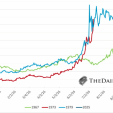Gold Falls as Ukrainian Worries Ease
San Francisco (Aug 18) Gold prices fell Monday, as last week's fears of a direct military confrontation between Russia and Ukraine have proven unfounded, leaving the precious metal vulnerable to concerns about higher interest rates in the U.S.
Gold for December delivery, the most actively traded contract, settled down $6.90, or 0.5%, at $1,299.30 an ounce on the Comex division of the New York Mercantile Exchange.
Ukrainian officials said Friday that the country's army had partially destroyed a column of Russian military vehicles that had entered its territory, The news sent gold prices higher on worries that the two countries were heading toward a military escalation. Some investors buy gold during times of geopolitical or economic uncertainty, believing the metal will hold its value better than other assets.
By Monday, however, there was little evidence that the conflict would widen, as Kiev sought to play down the clash's significance, while Moscow called reports of the battle "some kind of fantasy." Western officials criticized the apparent incursion, but some played down the significance of the incident, noting that military equipment were believed to have been flowing over the border to pro-Russia separatists for months.
Investors exited gold, which has been weighed down by worries of tightening monetary policy in the U.S. Higher interest rates are seen as a negative influence for gold, which costs money to hold and struggles to compete with yield-bearing investments. A stronger dollar and rising stocks also detracted from gold's appeal.
"The only real catalyst to own gold right now is geopolitical tension," said Frank Lesh, a broker at FuturePath Investments. "Without that factor in play, why own it?"
In other markets, palladium prices rose to a new, 13-year high amid the lingering tensions surrounding Russia. Palladium for September delivery settled at $894.90 a troy ounce, its highest closing price since Feb. 21, 2011. Russia is the world's leading producer of palladium, which is used in catalytic converters for cars.
Source: WSJ












